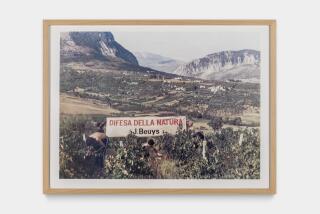Santa Monica
Imi Knoebel is a German painter who follows in the conceptual footsteps of his teacher Joseph Beuys with intentionally bland-to-the-point-of-stark abstractions or installations that can look like boxes crammed in a room for storage. Knoebel drains works of any allusive content, any reference to experience, feelings or knowledge, locking us into strict perceptions of materials, size, dimensions and relationships of work to environment, or work to work. This sounds like a redo of U.S. Minimalism, but it has a neo-German twist. Judd and company produced glistening industrial-looking ivory towers of inbred formal theory. Like Beuys’ imposing stacks of felt, Knoebel’s works lure us into highly conceptual ground with an everyday simplicity.
His paintings are composed of white paint faultlessly covering plywood panels joined into large geometric groupings. In one work, two mirror-image, inverted L shapes hug two slightly unequal rectangles that are set above two identically proportioned ones. The whole thing reads like one self-referential structure, with Knoebel intentionally sifting out distractions to force us to see how line relates to line, the weight of this shape to that, the pressure of one angle to another and how the row of balanced works acts as figure while the gallery space is ground.
This can be an enlightening but ultimately dry adventure; the pieces get good when you cast off Knoebel’s will to control and just let the paintings wash over you in all their hypnotic Malevich stillness. (Fred Hoffman Gallery, 912 Colorado St., to April 22.)
More to Read
The biggest entertainment stories
Get our big stories about Hollywood, film, television, music, arts, culture and more right in your inbox as soon as they publish.
You may occasionally receive promotional content from the Los Angeles Times.










